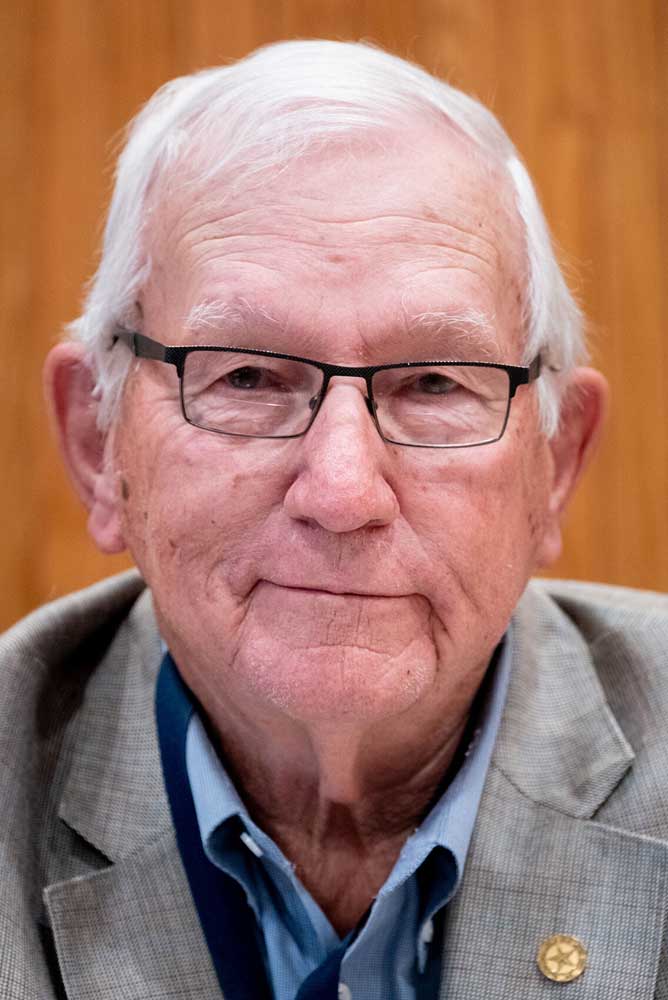‘Pray for rain’: Drought, heat straining East Texas ranchers, hay producers
Published 5:45 am Sunday, August 27, 2023

- Ronnie McKinneyRonnie McKinney
The sun’s been shining, but East Texas farmers haven’t been making much hay.
Drought and high temperatures have stunted the growth of hay fields, dried up ponds for livestock and depleted pasture grasses in the region, ranchers and hay producers say. Those factors are straining ranchers’ resources as they care for their livestock, increasing costs for producers and consumers alike.
Trending
“It’s a struggle right now, and it’s a tough struggle,” said Ronnie McKinney, a rancher and Pct. 1 Gregg County commissioner.
Long, hot summer
East Texas has had at least 31 days with temperatures of 100 degrees or more since July 18, according to data from the National Weather Service in Shreveport. Aug. 20 was the hottest day in Tyler, hitting 109.
A Sunday shower brought 0.34 inches of rain, which is the only precipitation received this month, according to weather service data. In July, Tyler saw just 0.66 inches of precipitation.
Spring rains gave producers a good hay crop earlier this year, but drought conditions have limited hay growth since then, said Alan Branham, owner of Longview Equipment, an agricultural equipment dealership.
Hay growers in the area normally expect to cut hay two or three times each year, Branham said. Some, however, still haven’t gotten a second cutting, and they don’t anticipate getting another one.
Trending
“It’s usually in September we start getting cold fronts,” Branham said. “October rolls around, and then you run out of growing time. So, even if we did get rain, the grass is already going dormant. So, if we don’t get rain in the next month, we’ll probably be out of time on growing grass.”
What hay remains in fields is thin and wiry, making it hard to cut, Branham said. High temperatures are testing tractors and baling equipment, increasing the risk for breakdowns and fires.
Some hay growers already are having their equipment serviced so they can put it in storage for the winter — almost three months earlier than usual, Branham said.
Branham, who grows and bales hay, said he has purchased additional hay from other growers so he can supply his customers this winter.
“Hay’s just getting real scarce right now,” he said.
Costs up, supplies down
Ranchers across the region are making changes to their operations to sustain their herds, said Shaniqua Davis, the Texas A&M AgriLife Extension agent in Gregg County.
Ponds have gotten drier, so some ranchers are hauling water and water tanks to their herds, she said.
Cattle have eaten down pasture grasses, forcing ranchers to provide supplemental hay and grain for their herds, Davis said. That means ranchers are feeding cattle earlier in the year, which increases costs and cuts into their already smaller winter hay stockpiles.
Hay and grain costs already are higher because of inflation. The U.S. Senate Committee on Agriculture, Nutrition & Forestry estimated in May that agricultural operations costs were expected to rise this year by 28%, around $87 billion — the biggest increase ever.
Anthony Brown, the Prairie View Cooperative agricultural extension agent in Smith County, said the price of a round bale of hay is ranging between $75 and $125.
“Since we’re not able to produce our hay or buy hay, we have to spend more money on hay this year, and then we have to sell off our livestock, so we have to reduce our cattle numbers,” he said.
This summer’s drought isn’t as severe as past droughts have been, and some ranchers were able to get enough hay to make bigger stockpiles for the winter, Davis said. However, cattle are eating less right now because of the high temperatures, so they’ll weigh less when they’re sold.
Potentially lower cattle weight, coupled with the reduced supply and increased cost of feeding, could force producers to make tough choices.
“They have to decide … if it’s going to be economically beneficial for them to feed out and sell cattle whenever they originally anticipated selling out, or if they need to thin their herd out and maybe start over whenever we’re not in the drought,” Davis said.
Buying cattle back at a more opportune time, however, may not be an option for some producers, Branham said. Cattle prices may be too high for ranchers to buy livestock back at a later date. Hay growers, in turn, lose money, too.
“Some of those people don’t come back,” Branham said. “It’s got long-term effects.”
Beef prices could rise
Although more cattle could be going to market, that doesn’t mean beef prices at grocery stores will drop.
Cattle prices are up because poor weather conditions during the past few years have caused many producers to sell off their herds, McKinney said. When herds are smaller, beef prices rise.
As of July 1, the nation had 29.4 million beef cattle, according to data from the U.S. Department of Agriculture. That’s the lowest figure since the agency first collected that data in 1971, officials with the University of Arkansas Division of Agriculture said in a news release.
McKinney’s advice to consumers is this: “If they want to buy beef, I’d buy it pretty quick. It’s not going to get any cheaper anytime soon.”
Although ranchers are selling their cattle for higher prices, they’re still facing higher input costs and remain at the mercy of the weather, he said.
“The poor old cattleman is at the bottom of the ladder,” McKinney said. “He’s not getting rich.”
‘Pray for rain’
The region’s high temperatures are the results of a high-pressure weather system in place over the central United States, said Thorne with the National Weather Service.
High-pressure systems bring hotter air and less precipitation into a region, he said.
Temperatures were cooling by about 10 degrees in the last days of August, Thorne said. Although the rainfall Sunday allowed for brief relief, the damage of the drought was already done.
“I don’t think it’s going to put a dent in our drought until we get a really good storm system to move through here, and I don’t see anything like that on the horizon right now,” Thorne said.
The Climate Prediction Center with the National Oceanic and Atmospheric Administration reported Aug. 17 that the region has about equal chances for above or below average precipitation through November.
“There’s no good indication that we’re going to be above or below in terms of precipitation,” Thorne said.
The region also has a chance for above average temperatures through November, but the average temperature will cool during the fall, Thorne said.
Drought has affected most of the Lone Star State. The worst of the drought is in the central and southeast parts Texas, which are experiencing extreme and exceptional drought, the U.S. Drought Monitor reported Aug. 24.
Gregg, Smith and Upshur counties are in a moderate drought, though the southeast corner of Smith County is in a severe drought.
Dry conditions and high temperatures have fueled wildfires across the state in recent weeks. Most have have occurred in Central and East Texas, according to the Texas A&M Forest Service’s online incident map.
According to forest service data, 564 fires burned more than 66,000 acres between July 1 and Aug. 25. By comparison, 629 fires burned more than 68,000 acres during the same period last year.
The forest service reported Friday that 208 counties have burn bans in place, including Gregg, Upshur and Smith.
Branham said he’s hopeful that rain will sweep across the region again soon.
“Pray for rain,” he said. “The Good Lord, He’ll give us rain when He thinks we need it.”
This summer is one of the hotter ones McKinney remembers, but 2011 was the worst, he said.






